Chenxi Whitehouse
What Is That Talk About? A Video-to-Text Summarization Dataset for Scientific Presentations
Feb 12, 2025Abstract:Transforming recorded videos into concise and accurate textual summaries is a growing challenge in multimodal learning. This paper introduces VISTA, a dataset specifically designed for video-to-text summarization in scientific domains. VISTA contains 18,599 recorded AI conference presentations paired with their corresponding paper abstracts. We benchmark the performance of state-of-the-art large models and apply a plan-based framework to better capture the structured nature of abstracts. Both human and automated evaluations confirm that explicit planning enhances summary quality and factual consistency. However, a considerable gap remains between models and human performance, highlighting the challenges of scientific video summarization.
Segment-Level Diffusion: A Framework for Controllable Long-Form Generation with Diffusion Language Models
Dec 15, 2024



Abstract:Diffusion models have shown promise in text generation but often struggle with generating long, coherent, and contextually accurate text. Token-level diffusion overlooks word-order dependencies and enforces short output windows, while passage-level diffusion struggles with learning robust representation for long-form text. To address these challenges, we propose Segment-Level Diffusion (SLD), a framework that enhances diffusion-based text generation through text segmentation, robust representation training with adversarial and contrastive learning, and improved latent-space guidance. By segmenting long-form outputs into separate latent representations and decoding them with an autoregressive decoder, SLD simplifies diffusion predictions and improves scalability. Experiments on XSum, ROCStories, DialogSum, and DeliData demonstrate that SLD achieves competitive or superior performance in fluency, coherence, and contextual compatibility across automatic and human evaluation metrics comparing with other diffusion and autoregressive baselines. Ablation studies further validate the effectiveness of our segmentation and representation learning strategies.
The Automated Verification of Textual Claims (AVeriTeC) Shared Task
Oct 31, 2024



Abstract:The Automated Verification of Textual Claims (AVeriTeC) shared task asks participants to retrieve evidence and predict veracity for real-world claims checked by fact-checkers. Evidence can be found either via a search engine, or via a knowledge store provided by the organisers. Submissions are evaluated using AVeriTeC score, which considers a claim to be accurately verified if and only if both the verdict is correct and retrieved evidence is considered to meet a certain quality threshold. The shared task received 21 submissions, 18 of which surpassed our baseline. The winning team was TUDA_MAI with an AVeriTeC score of 63%. In this paper we describe the shared task, present the full results, and highlight key takeaways from the shared task.
SEACrowd: A Multilingual Multimodal Data Hub and Benchmark Suite for Southeast Asian Languages
Jun 14, 2024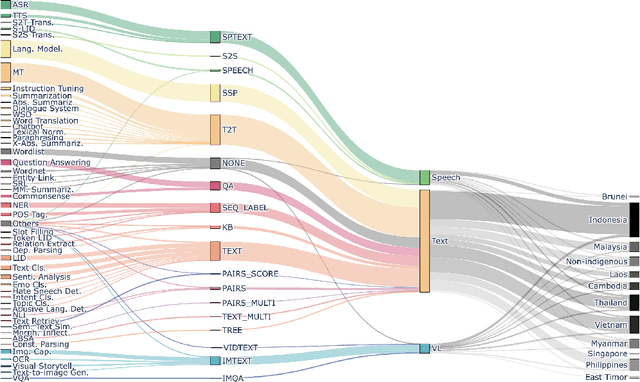
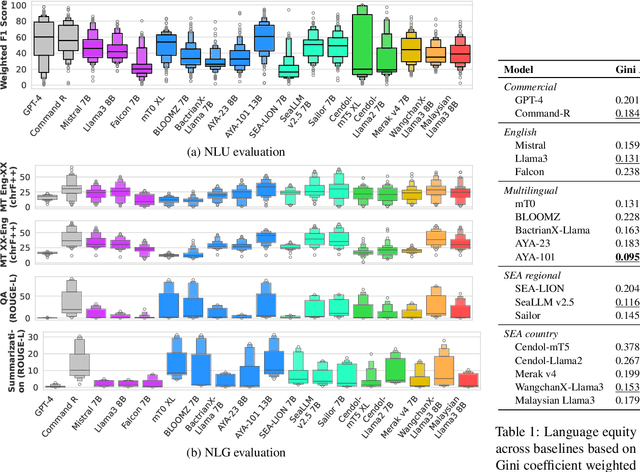
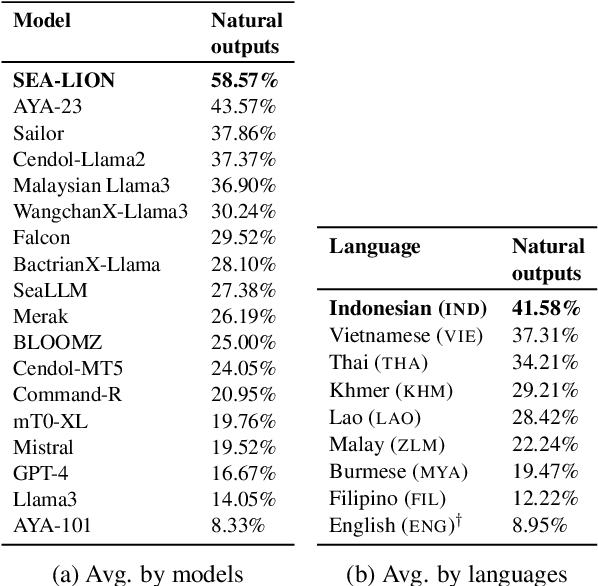
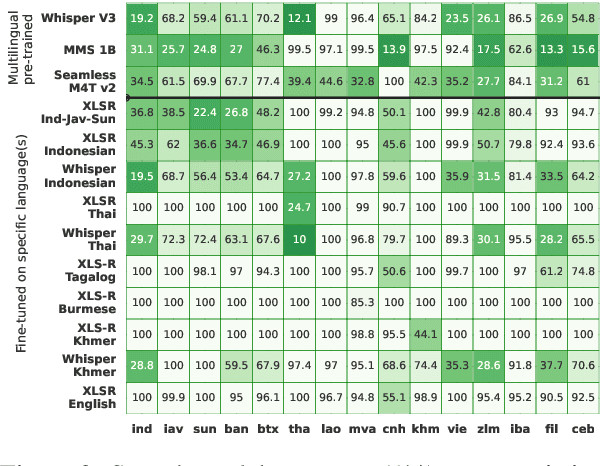
Abstract:Southeast Asia (SEA) is a region rich in linguistic diversity and cultural variety, with over 1,300 indigenous languages and a population of 671 million people. However, prevailing AI models suffer from a significant lack of representation of texts, images, and audio datasets from SEA, compromising the quality of AI models for SEA languages. Evaluating models for SEA languages is challenging due to the scarcity of high-quality datasets, compounded by the dominance of English training data, raising concerns about potential cultural misrepresentation. To address these challenges, we introduce SEACrowd, a collaborative initiative that consolidates a comprehensive resource hub that fills the resource gap by providing standardized corpora in nearly 1,000 SEA languages across three modalities. Through our SEACrowd benchmarks, we assess the quality of AI models on 36 indigenous languages across 13 tasks, offering valuable insights into the current AI landscape in SEA. Furthermore, we propose strategies to facilitate greater AI advancements, maximizing potential utility and resource equity for the future of AI in SEA.
CVQA: Culturally-diverse Multilingual Visual Question Answering Benchmark
Jun 10, 2024



Abstract:Visual Question Answering (VQA) is an important task in multimodal AI, and it is often used to test the ability of vision-language models to understand and reason on knowledge present in both visual and textual data. However, most of the current VQA models use datasets that are primarily focused on English and a few major world languages, with images that are typically Western-centric. While recent efforts have tried to increase the number of languages covered on VQA datasets, they still lack diversity in low-resource languages. More importantly, although these datasets often extend their linguistic range via translation or some other approaches, they usually keep images the same, resulting in narrow cultural representation. To address these limitations, we construct CVQA, a new Culturally-diverse multilingual Visual Question Answering benchmark, designed to cover a rich set of languages and cultures, where we engage native speakers and cultural experts in the data collection process. As a result, CVQA includes culturally-driven images and questions from across 28 countries on four continents, covering 26 languages with 11 scripts, providing a total of 9k questions. We then benchmark several Multimodal Large Language Models (MLLMs) on CVQA, and show that the dataset is challenging for the current state-of-the-art models. This benchmark can serve as a probing evaluation suite for assessing the cultural capability and bias of multimodal models and hopefully encourage more research efforts toward increasing cultural awareness and linguistic diversity in this field.
SemEval-2024 Task 8: Multidomain, Multimodel and Multilingual Machine-Generated Text Detection
Apr 22, 2024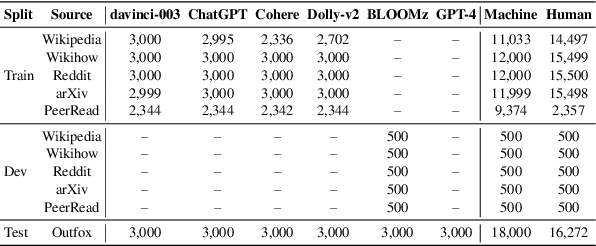



Abstract:We present the results and the main findings of SemEval-2024 Task 8: Multigenerator, Multidomain, and Multilingual Machine-Generated Text Detection. The task featured three subtasks. Subtask A is a binary classification task determining whether a text is written by a human or generated by a machine. This subtask has two tracks: a monolingual track focused solely on English texts and a multilingual track. Subtask B is to detect the exact source of a text, discerning whether it is written by a human or generated by a specific LLM. Subtask C aims to identify the changing point within a text, at which the authorship transitions from human to machine. The task attracted a large number of participants: subtask A monolingual (126), subtask A multilingual (59), subtask B (70), and subtask C (30). In this paper, we present the task, analyze the results, and discuss the system submissions and the methods they used. For all subtasks, the best systems used LLMs.
* 23 pages, 12 tables
PRobELM: Plausibility Ranking Evaluation for Language Models
Apr 04, 2024Abstract:This paper introduces PRobELM (Plausibility Ranking Evaluation for Language Models), a benchmark designed to assess language models' ability to discern more plausible from less plausible scenarios through their parametric knowledge. While benchmarks such as TruthfulQA emphasise factual accuracy or truthfulness, and others such as COPA explore plausible scenarios without explicitly incorporating world knowledge, PRobELM seeks to bridge this gap by evaluating models' capabilities to prioritise plausible scenarios that leverage world knowledge over less plausible alternatives. This design allows us to assess the potential of language models for downstream use cases such as literature-based discovery where the focus is on identifying information that is likely but not yet known. Our benchmark is constructed from a dataset curated from Wikidata edit histories, tailored to align the temporal bounds of the training data for the evaluated models. PRobELM facilitates the evaluation of language models across multiple prompting types, including statement, text completion, and question-answering. Experiments with 10 models of various sizes and architectures on the relationship between model scales, training recency, and plausibility performance, reveal that factual accuracy does not directly correlate with plausibility performance and that up-to-date training data enhances plausibility assessment across different model architectures.
Towards Knowledge-Grounded Natural Language Understanding and Generation
Mar 22, 2024Abstract:This thesis investigates how natural language understanding and generation with transformer models can benefit from grounding the models with knowledge representations and addresses the following key research questions: (i) Can knowledge of entities extend its benefits beyond entity-centric tasks, such as entity linking? (ii) How can we faithfully and effectively extract such structured knowledge from raw text, especially noisy web text? (iii) How do other types of knowledge, beyond structured knowledge, contribute to improving NLP tasks? Studies in this thesis find that incorporating relevant and up-to-date knowledge of entities benefits fake news detection, and entity-focused code-switching significantly enhances zero-shot cross-lingual transfer on entity-centric tasks. In terms of effective and faithful approaches to extracting structured knowledge, it is observed that integrating negative examples and training with entity planning significantly improves performance. Additionally, it is established that other general forms of knowledge, such as parametric and distilled knowledge, enhance multimodal and multilingual knowledge-intensive tasks. This research shows the tangible benefits of diverse knowledge integration and motivates further exploration in this direction.
Multitask Multilingual Model Adaptation with Featurized Low-Rank Mixtures
Feb 27, 2024Abstract:Adapting pretrained large language models (LLMs) to various downstream tasks in tens or hundreds of human languages is computationally expensive. Parameter-efficient fine-tuning (PEFT) significantly reduces the adaptation cost, by tuning only a small amount of parameters. However, directly applying PEFT methods such as LoRA (Hu et al., 2022) on diverse dataset mixtures could lead to suboptimal performance due to limited parameter capacity and negative interference among different datasets. In this work, we propose Featurized Low-rank Mixtures (FLix), a novel PEFT method designed for effective multitask multilingual tuning. FLix associates each unique dataset feature, such as the dataset's language or task, with its own low-rank weight update parameters. By composing feature-specific parameters for each dataset, FLix can accommodate diverse dataset mixtures and generalize better to unseen datasets. Our experiments show that FLix leads to significant improvements over a variety of tasks for both supervised learning and zero-shot settings using different training data mixtures.
Parameter-Efficient Multilingual Summarisation: An Empirical Study
Nov 14, 2023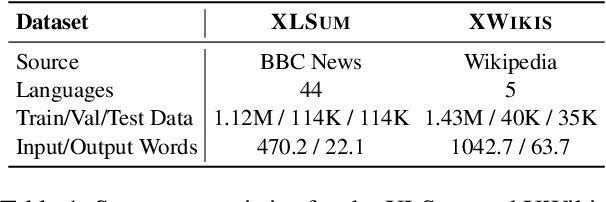
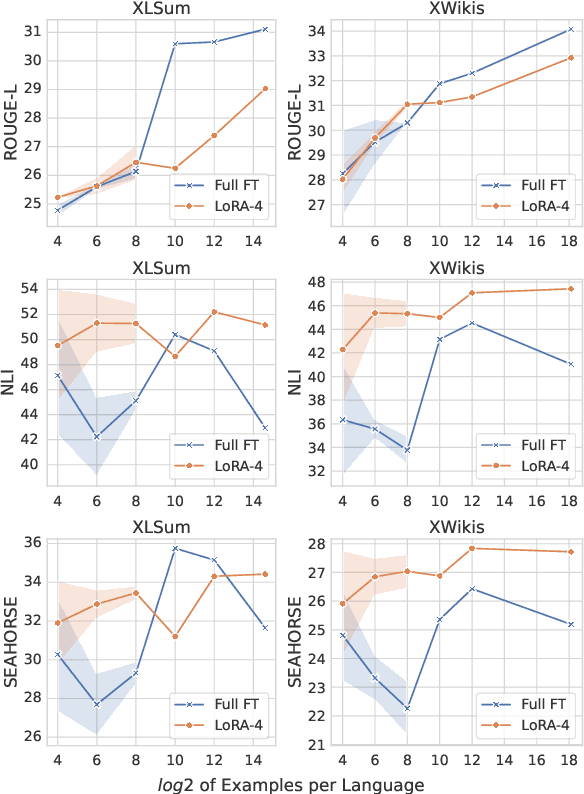
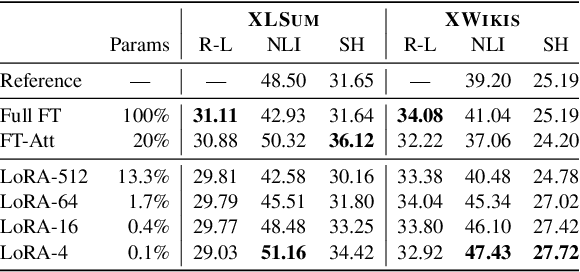
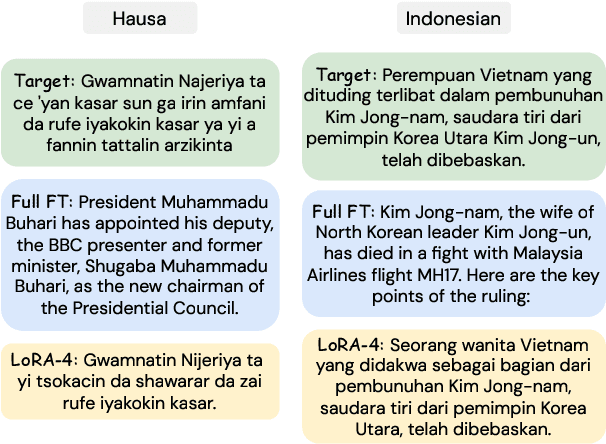
Abstract:With the increasing prevalence of Large Language Models, traditional full fine-tuning approaches face growing challenges, especially in memory-intensive tasks. This paper investigates the potential of Parameter-Efficient Fine-Tuning, focusing on Low-Rank Adaptation (LoRA), for complex and under-explored multilingual summarisation tasks. We conduct an extensive study across different data availability scenarios, including full-data, low-data, and cross-lingual transfer, leveraging models of different sizes. Our findings reveal that LoRA lags behind full fine-tuning when trained with full data, however, it excels in low-data scenarios and cross-lingual transfer. Interestingly, as models scale up, the performance gap between LoRA and full fine-tuning diminishes. Additionally, we investigate effective strategies for few-shot cross-lingual transfer, finding that continued LoRA tuning achieves the best performance compared to both full fine-tuning and dynamic composition of language-specific LoRA modules.
 Add to Chrome
Add to Chrome Add to Firefox
Add to Firefox Add to Edge
Add to Edge